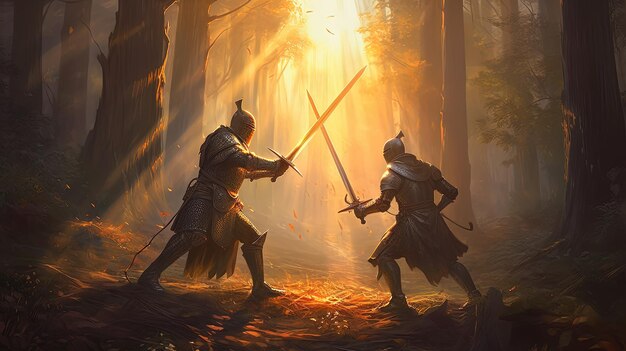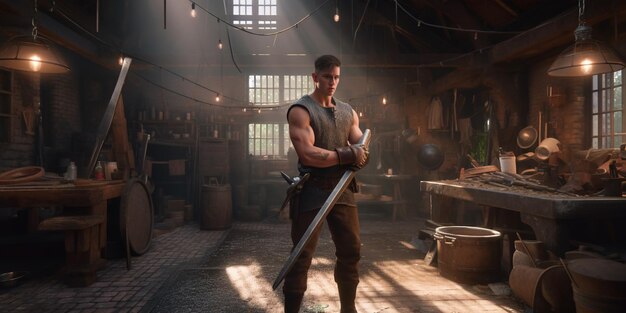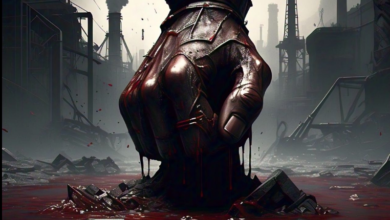Rediscovering the Blade Craftsmanship and Chivalry in Swordbirth Rise of the Swordians Age of Swords

Medieval history is flourishing once again, but not in the dusty pages of textbooks. It’s alive and thriving in a modern movement known as Swordbirth. This phenomenon encapsulates the resurgence of sword-making and swordplay, drawing in enthusiasts from across the globe. Intrigued? Let’s unsheathe the fascinating world of Swordbirth!
Introduction to the Swordbirth Phenomenon
Swordbirth, a term that’s gaining traction among medieval history buffs, refers to the burgeoning interest in medieval sword-making and swordplay. This resurgence is not just about wielding swords; it’s about immersing oneself in the rich tapestry of history that these weapons represent. Enthusiasts are not only learning the skills of ancient swordsmanship but are also deeply invested in the cultural and historical significance of these practices.
Why is there a sudden spike in interest towards these archaic arts? For many, it’s an escape into a past where honor, chivalry, and craftsmanship reigned supreme. With the rise of fantasy media, historical reenactments, and collectible hobbies, Swordbirth offers a nostalgic yet enriching pursuit. Through this blog post, we’ll explore the intricate world of Swordbirth, its cultural roots, and why it’s captivating modern audiences.
The Rise of Swordians
The subculture of Swordians, devotees of Swordbirth, is a fascinating subject. Originating from a blend of historical reenactment societies and martial arts enthusiasts, this community has grown exponentially in recent years. The term “Swordian” itself embodies a sense of identity tied to the mastery and appreciation of medieval weaponry.
Rituals and community activities are integral to the Swordian experience. From forging swords to participating in medieval combat tournaments, these rituals are not merely hobbies but a way of life. Weekly meets, training sessions, and historical discussions dominate the calendars of Swordians, fostering a close-knit community that shares a passion for the past.
The community’s activities are diverse—ranging from sword dancing to historical lectures. Social media plays a significant role in connecting Swordians worldwide, allowing them to share techniques, showcase their craftsmanship, and organize events. This digital camaraderie has enabled the movement to transcend geographical boundaries, making it a truly global phenomenon swordbirth: rise of the swordians: age of swords.
The Age of Swords
To understand the current fascination with Swordbirth, we must look back at the historical context of medieval weaponry. The Middle Ages were a period where swords were not just tools of war but symbols of power, honor, and prestige. The craftsmanship of these blades reflected the socio-economic and cultural fabric of the time.
The renewed interest in medieval weaponry can be attributed to several factors. Firstly, the craftsmanship involved in making a sword is an art form that appeals to those who appreciate fine workmanship. Secondly, the romanticized portrayal of medieval times in movies, books, and games has fueled the desire to experience a piece of that era firsthand.
Furthermore, in an age dominated by rapidly advancing technology, there’s a growing appreciation for traditional skills and crafts. Sword-making and swordplay offer a tangible connection to the past, a stark contrast to the intangible digital world we live in today. This yearning for a simpler, more honorable time is at the heart of the Swordbirth movement.

Interview with a Modern Swordsmith
To gain deeper insights into the world of Swordbirth, I sat down with John Smith, a renowned modern swordsmith. John’s workshop is a blend of ancient techniques and modern tools, reflecting the duality of his craft.
Q: What inspired you to become a swordsmith?
A: I’ve always been fascinated by medieval history, especially the craftsmanship of that era. The idea of creating something that’s both beautiful and functional drew me to sword-making. It’s an art that requires patience, precision, and passion.
Q: How do you balance traditional techniques with modern technology?
A: While I respect traditional methods, incorporating modern technology allows for greater precision and efficiency. For instance, using a power hammer speeds up the process of forging, but the final touches are always done by hand to ensure authenticity and quality.
Q: What’s your take on the Swordbirth movement?
A: I think it’s incredible. It’s not just about making or wielding swords; it’s about preserving a part of our history. The community is passionate and dedicated, and it’s heartening to see so many people appreciating the art and history of sword-making swordbirth: rise of the swordians: age of swords.
Community Spotlight
The Swordbirth movement is driven by passionate individuals who have dedicated their lives to preserving and promoting medieval swordsmanship. Let’s take a closer look at some prominent figures in the Swordians community who have made significant contributions.
Emily Jones, a historical consultant and swordplay instructor, has been instrumental in organizing medieval combat tournaments. Her workshops and lectures on historical European martial arts (HEMA) have inspired many to take up the sword.
Michael Brown, a social media influencer and YouTuber, has brought the world of Swordbirth to a broader audience. His channel, which features tutorials, historical analyses, and event coverage, has garnered a substantial following, making medieval history accessible and engaging.
Sarah Lee, an award-winning swordsmith, has elevated the craft to new heights with her meticulously crafted blades. Her work, which combines traditional techniques with contemporary designs, has earned her accolades and a loyal customer base.
The Future of Swordbirth
The Swordbirth movement shows no signs of slowing down. Its sustainability and potential growth lie in its ability to adapt and innovate while staying true to its roots. The community’s influence on popular culture is evident, with more people drawn to the art and history of sword-making and swordplay.
One promising avenue is the integration of Swordbirth into educational curricula. Schools and universities are beginning to recognize the value of teaching historical martial arts and craftsmanship, providing students with a hands-on understanding of history.
Additionally, collaborations with the entertainment industry offer exciting opportunities for growth. Films, TV shows swordbirth: rise of the swordians: age of swords, and video games that accurately depict medieval combat and weaponry can introduce Swordbirth to new audiences, further expanding its reach.
Conclusion
The resurgence of Swordbirth is a testament to the enduring allure of medieval history and craftsmanship. From the intricate artistry of sword-making to the disciplined practice of swordplay, this movement offers a unique blend of tradition and innovation. For medieval history enthusiasts, Swordbirth is more than a hobby; it’s a way of life that connects them to a bygone era of honor and artistry.
For those eager to explore this fascinating world further, joining the Swordians community is a great start. Engage with experts, attend events, and perhaps even try your hand at forging your own blade. The age of swords is upon us, and it promises an enriching and exhilarating adventure for all who dare to wield it.

